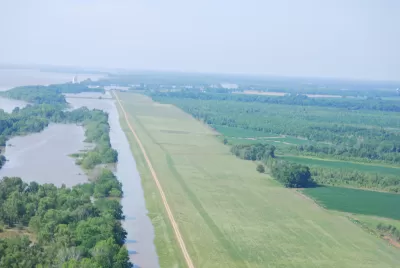Levees can save towns, but they can also push water downstream making floods worse, meaning that if wealthier places are protected, it’s sometimes at the expense of poor communities.

Where rivers flood, the most common technique used by the Army Corps of Engineers to protect homes is to build levees. Reporting from ProPublica suggest that this strategy creates some harm. When rivers don't overflow their banks, that water has to go somewhere, so levees that protect one area can worsen flooding in somewhere else. This makes the placement of levees a sticky issue.
The Army Corps of Engineers tries to prevent property damage so it looks at the value of land and homes near rivers and uses that information to help decide where to build levees. "But the calculations favor highly valued property over less affluent communities. And the Corps has favored levee-building over nonstructural fixes such as buying out homes to create space for the river to spread out during a flood — practices that many experts say are more effective in the long run, but which the Corps concluded were 'seldom economically justified,'" report Lisa Song, Patrick Michels, and Al Shaw for ProPublica. As climate change exacerbates extreme weather, flood infrastructure is going to become increasingly important.
FULL STORY: Flood Thy Neighbor: Who Stays Dry and Who Decides?

Planetizen Federal Action Tracker
A weekly monitor of how Trump’s orders and actions are impacting planners and planning in America.

Maui's Vacation Rental Debate Turns Ugly
Verbal attacks, misinformation campaigns and fistfights plague a high-stakes debate to convert thousands of vacation rentals into long-term housing.

San Francisco Suspends Traffic Calming Amidst Record Deaths
Citing “a challenging fiscal landscape,” the city will cease the program on the heels of 42 traffic deaths, including 24 pedestrians.

Amtrak Rolls Out New Orleans to Alabama “Mardi Gras” Train
The new service will operate morning and evening departures between Mobile and New Orleans.

The Subversive Car-Free Guide to Trump's Great American Road Trip
Car-free ways to access Chicagoland’s best tourist attractions.

San Antonio and Austin are Fusing Into one Massive Megaregion
The region spanning the two central Texas cities is growing fast, posing challenges for local infrastructure and water supplies.
Urban Design for Planners 1: Software Tools
This six-course series explores essential urban design concepts using open source software and equips planners with the tools they need to participate fully in the urban design process.
Planning for Universal Design
Learn the tools for implementing Universal Design in planning regulations.
Heyer Gruel & Associates PA
JM Goldson LLC
Custer County Colorado
City of Camden Redevelopment Agency
City of Astoria
Transportation Research & Education Center (TREC) at Portland State University
Jefferson Parish Government
Camden Redevelopment Agency
City of Claremont


























